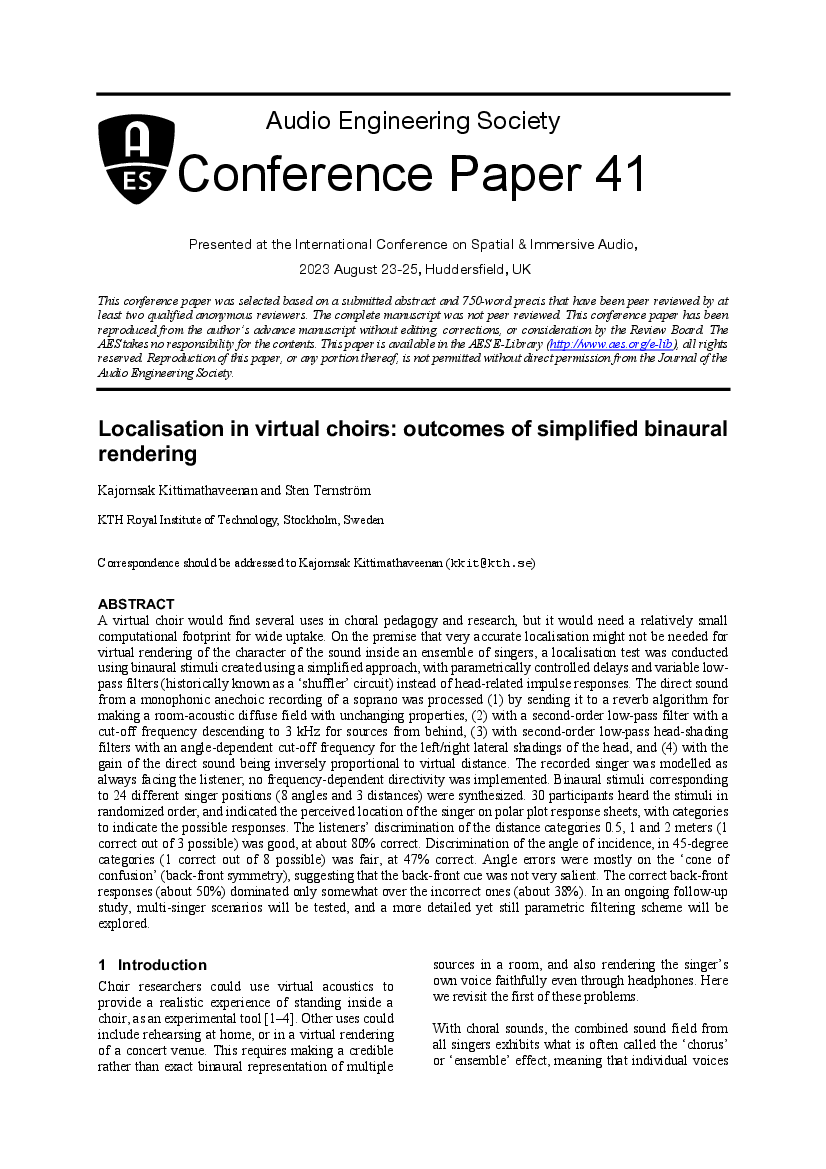Home / Publications / E-library page
You are currently logged in as an
Institutional Subscriber.
If you would like to logout,
please click on the button below.
Home / Publications / E-library page
Only AES members and Institutional Journal Subscribers can download
A virtual choir would find several uses in choral pedagogy and research, but it would need a relatively small computational footprint for wide uptake. On the premise that very accurate localisation might not be needed for virtual rendering of the character of the sound inside an ensemble of singers, a localisation test was conducted using binaural stimuli created using a simplified approach, with parametrically controlled delays and variable low-pass filters (historically known as a ‘shuffler’ circuit) instead of head-related impulse responses. The direct sound from a monophonic anechoic recording of a soprano was processed (1) by sending it to a reverb algorithm for making a room-acoustic diffuse field with unchanging properties, (2) with a second-order low-pass filter with a cut-off frequency descending to 3 kHz for sources from behind, (3) with second-order low-pass head-shading filters with an angle-dependent cut-off frequency for the left/right lateral shadings of the head, and (4) with the gain of the direct sound being inversely proportional to virtual distance. The recorded singer was modelled as always facing the listener; no frequency-dependent directivity was implemented. Binaural stimuli corresponding to 24 different singer positions (8 angles and 3 distances) were synthesized. 30 participants heard the stimuli in randomized order, and indicated the perceived location of the singer on polar plot response sheets, with categories to indicate the possible responses. The listeners’ discrimination of the distance categories 0.5, 1 and 2 meters (1 correct out of 3 possible) was good, at about 80% correct. Discrimination of the angle of incidence, in 45-degree categories (1 correct out of 8 possible) was fair, at 47% correct. Angle errors were mostly on the ‘cone of confusion’ (back-front symmetry), suggesting that the back-front cue was not very salient. The correct back-front responses (about 50%) dominated only somewhat over the incorrect ones (about 38%). In an ongoing follow-up study, multi-singer scenarios will be tested, and a more detailed yet still parametric filtering scheme will be explored.
Author (s): Kittimathaveenan, Kajornsak; Ternström, Sten
Affiliation:
KTH Royal Institute of Technology, Stockholm, Sweden; KTH Royal Institute of Technology, Stockholm, Sweden
(See document for exact affiliation information.)
Publication Date:
2023-08-06
Import into BibTeX
Session subject:
Paper
Permalink: https://aes2.org/publications/elibrary-page/?id=22177
(457KB)
Click to purchase paper as a non-member or login as an AES member. If your company or school subscribes to the E-Library then switch to the institutional version. If you are not an AES member Join the AES. If you need to check your member status, login to the Member Portal.

Kittimathaveenan, Kajornsak; Ternström, Sten; 2023; Localisation in virtual choirs: outcomes of simplified binaural rendering [PDF]; KTH Royal Institute of Technology, Stockholm, Sweden; KTH Royal Institute of Technology, Stockholm, Sweden; Paper 41; Available from: https://aes2.org/publications/elibrary-page/?id=22177
Kittimathaveenan, Kajornsak; Ternström, Sten; Localisation in virtual choirs: outcomes of simplified binaural rendering [PDF]; KTH Royal Institute of Technology, Stockholm, Sweden; KTH Royal Institute of Technology, Stockholm, Sweden; Paper 41; 2023 Available: https://aes2.org/publications/elibrary-page/?id=22177